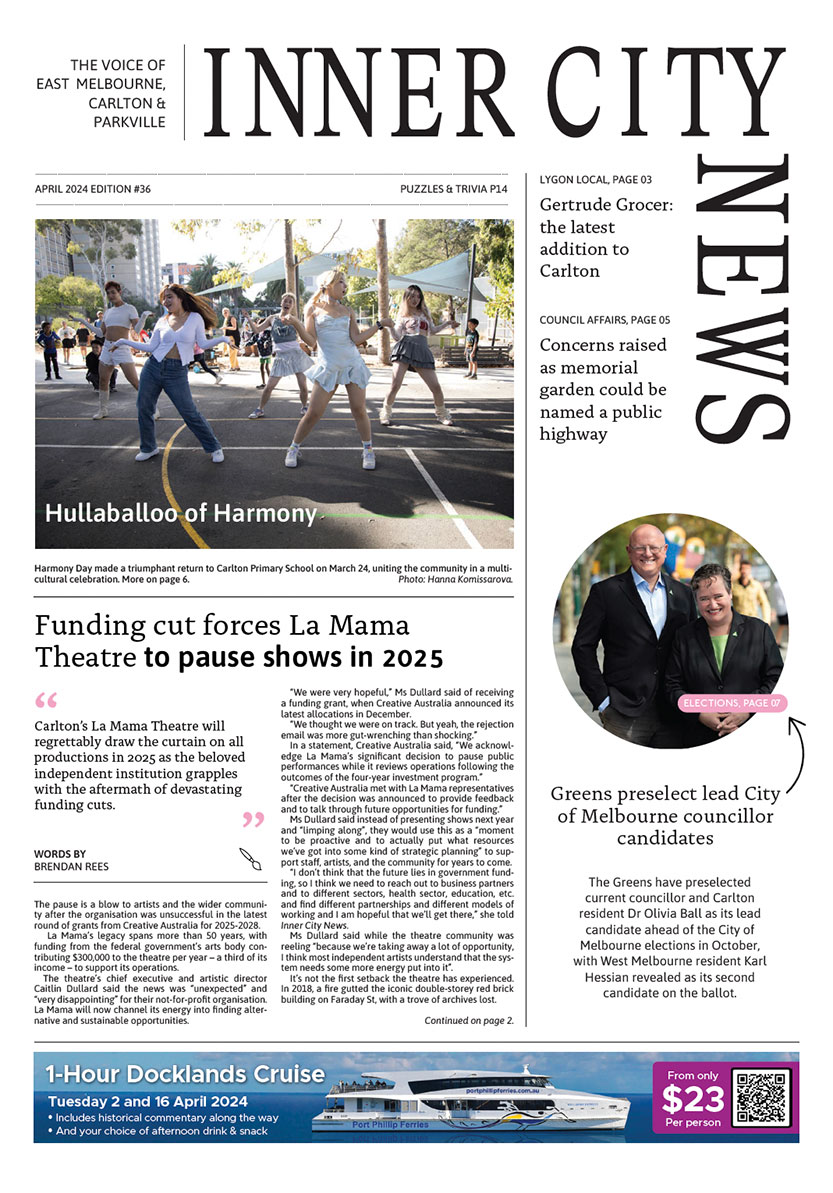George Page Cooper – art collector
By Tim Holland
East Melbourne Historical Society is researching the lives of the names that were on the World War One Honour Roll of the old Yarra Park State School that was situated on the corner of Wellington Parade and Punt Rd between 1874 and 1987. There are many interesting stories that have come out of this research, and one such story is that of George Page Cooper.
Cooper was born at Prahran on June 5, 1893 to Henrietta O’Brien and George Taylor Patrick Cooper, a butcher. He attended Yarra Park School and when he enlisted on July 6, 1915, he gave his occupation as “clerk” although the electoral rolls for 1914 show his occupation as “musician”. His address on enlistment was his parents’ home at 2 Lyndurst St, Richmond. He was just short of five feet, seven inches and weighed 11 stone.
He embarked on the Wiltshire on October 15, 1915 with the 21st Battalion. During his service he transferred to the 60th Battalion, then to the 57th Battalion. In France he moved up the ranks and finished the war as a Lieutenant in the 60th Battalion, having attended officer school at Cambridge – indicative of a very good service record. At the end of the war, he embarked for Australia on the Main on July 23, 1919.
After the war George Cooper seems to have done quite well for himself. He appears to have styled himself as George Page-Cooper, and ran a business, Page-Cooper Mercantile Agency, from his beautiful home “The Elms” at 6 Waltham St, Richmond, which is still standing. In newspaper articles written after his death in 1967 it was said that his “Mercantile Agency” was, in fact, a debt collection business. He was also a Labor councillor on the Richmond City Council.
It’s not clear when but early in his life George became an avid collector of art. Throughout the 1920s, he collected a large number of European artworks which he apparently disposed of at a number of auctions in 1926 and then began collecting Australian artworks and historical artefacts.
Shiraheen Huda writes about him in the 2008 book – Pedigree and Panache: A History of the Art Auction in Australia. A particular aspect of interest is the auction of his estate items by Leonard Joel on November 21-22 1967 at Malvern Town Hall. This auction has been referred to down the years as a significant event in the history and development of the art market in Australia. At the time Leonard Joel said, “the auction was unprecedented in Australian history, both in importance and prices paid.” Works by Buvelot, Streeton, Conder and S.T. Gill were among the items in the extensive catalogue, and the event is said to have helped in developing interest in the collecting of works by Australian artists and the potential for art to be seen as an investment. An example cited is an 1853 painting of a Hobart scene by Knut Bull which sold for $90 in the 1967 sale but was subsequently resold in 1991 by Leonard Joel for $77,000. The 1967 auction was of 404 items, but he had also disposed of a lot of other paintings earlier in the 1960s.
In about 1940, Cooper became involved in the management of an art gallery, the Velasquez Gallery, later known as Tye’s Art Gallery, located at the rear and in the basement of Tye’s Art Furniture Building at 100 Bourke St in the city.
Cooper’s house in Richmond was apparently jam-packed with artworks, and when he moved to 24 Studley Ave, Kew late in his life it is recorded that he personally moved all his artwork from one house to the other in 200 car trips.
He died unmarried on May 18, 1967, and there is an endearing In Memoriam newspaper notice to him by a niece on the 7th anniversary of his death. He also seems to have published a 300-page scrapbook of his wartime experiences.
In 1932 there were reports in newspapers around the country of Cooper having bought a painting for nine pounds at a jumble sale, and proclaiming that it was in fact a Gainsborough valued at 10,000 pounds. Contemporary reports said he was about to travel with the painting to England, presumably to sell, but there were no further reports as to the outcome of this alleged “find”.
Huda in her book says that contemporary news reports commented that he was “a familiar figure in the city’s auction rooms, generally wearing a battered hat and open necked shirt.”
Shortly after his death there were a number of stories about him reported in the Sun and Herald newspapers by Tom Prior and a young Scot Palmer. Scot remembered him from seeing him walking around Richmond with his dogs: “he always had dogs”. His love of dogs received extensive press attention when his will provided a then very generous $20 a week for maintenance of his 10-year-old black Labrador. His substantial estate gave life interests to his three siblings, these interests reverting to the Lort Smith Home and other charities upon their deaths. Unfortunately, there seems to have been litigation over these provisions, which would have reduced the size of the pie.
One of his Tye’s Gallery colleagues had written a poem about him which started with: “And what about our George Page Cooper?”, and ended with:
When he gets home, his pups, acquiver
Sit begging, for their beef and liver!
He’s erudite. He’s read each book
From Shakespeare down to Rupert Brooke,
And that’s not all, there’s still some more
‘E’s an hero of the First World War!
An interesting life, indeed!
Tim Holland, president East Melbourne Historical Society
[email protected] and emhs.org.au •

Carlton language school championed by Ukrainian refugee




 Download the Latest Edition
Download the Latest Edition